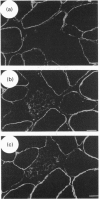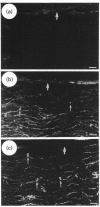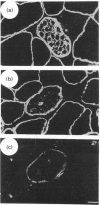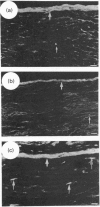Abstract
Differential expression of proteins belonging to the dystrophin family was analysed in peripheral nerves. In agreement with previous reports, no full-size dystrophin was detectable, only Dp116, one of the short dystrophin products of the Duchenne muscular dystrophy (DMD) gene. We used specific monoclonal antibodies to fully investigate the presence of utrophin, a dystrophin homologue encoded by a gene located on chromosome 6q24. Evidence is presented here of the presence of two potential isoforms of full-length utrophin in different nerve structures, which may differ by alternative splicing of the 3'-terminal part of the utrophin gene according to the specificities of the monoclonal antiobodies used. One full-length utrophin was co-localized with Dp116 in the sheath around each separate Schwann cell-axon unit, but the other utrophin isoform was found to be perineurium-specific. We also highlighted a potential 80 kDa utrophin-related protein. The utrophin distribution in peripheral nerves was re-evaluated and utrophin isoforms were detected at the protein level. This preliminary indication will require more concrete molecular evidence to confirm the presence of these two utrophin isoforms as well as the potential 80 kDa utrophin isoform, but the results strongly suggest that each isoform must have a specialized role and function within each specific nervous structure.
Full text
PDF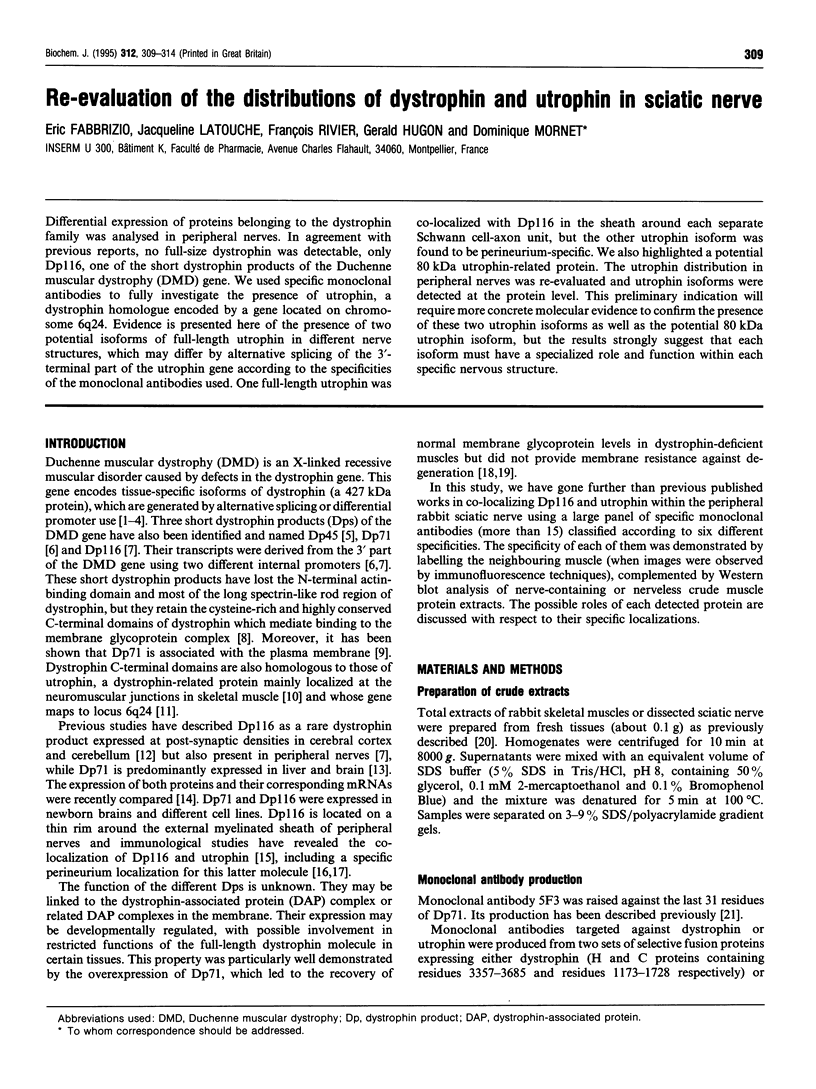
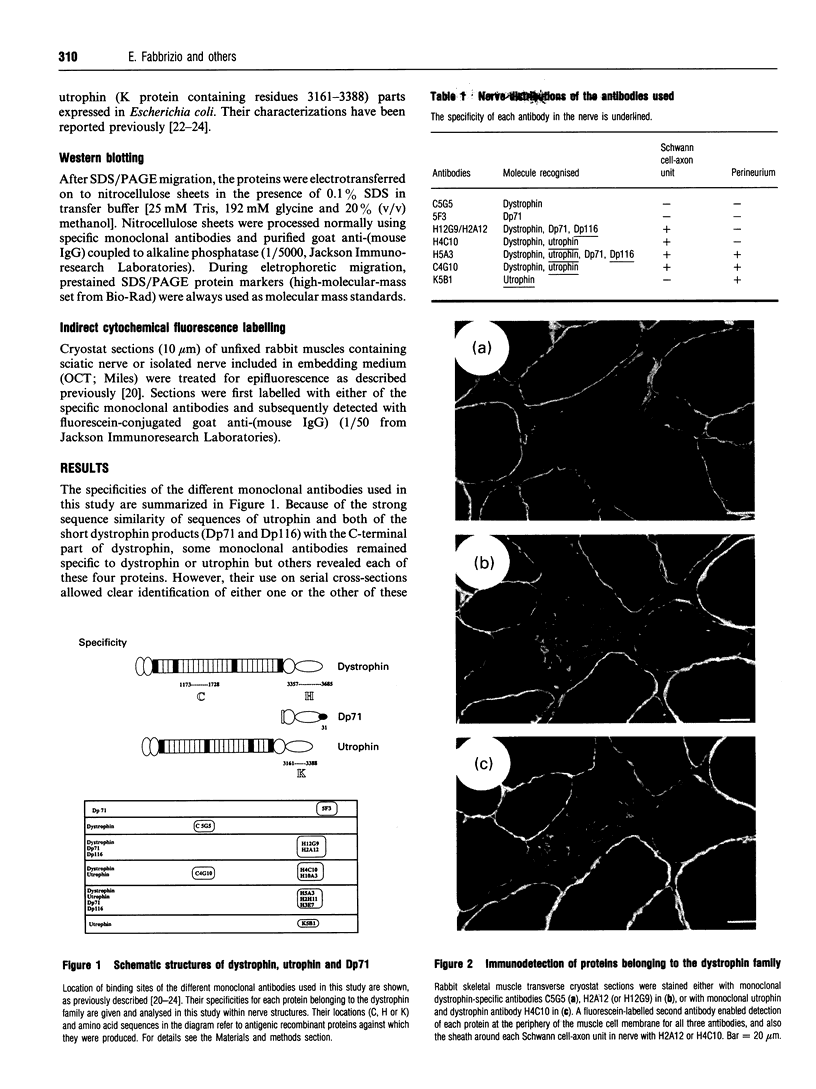
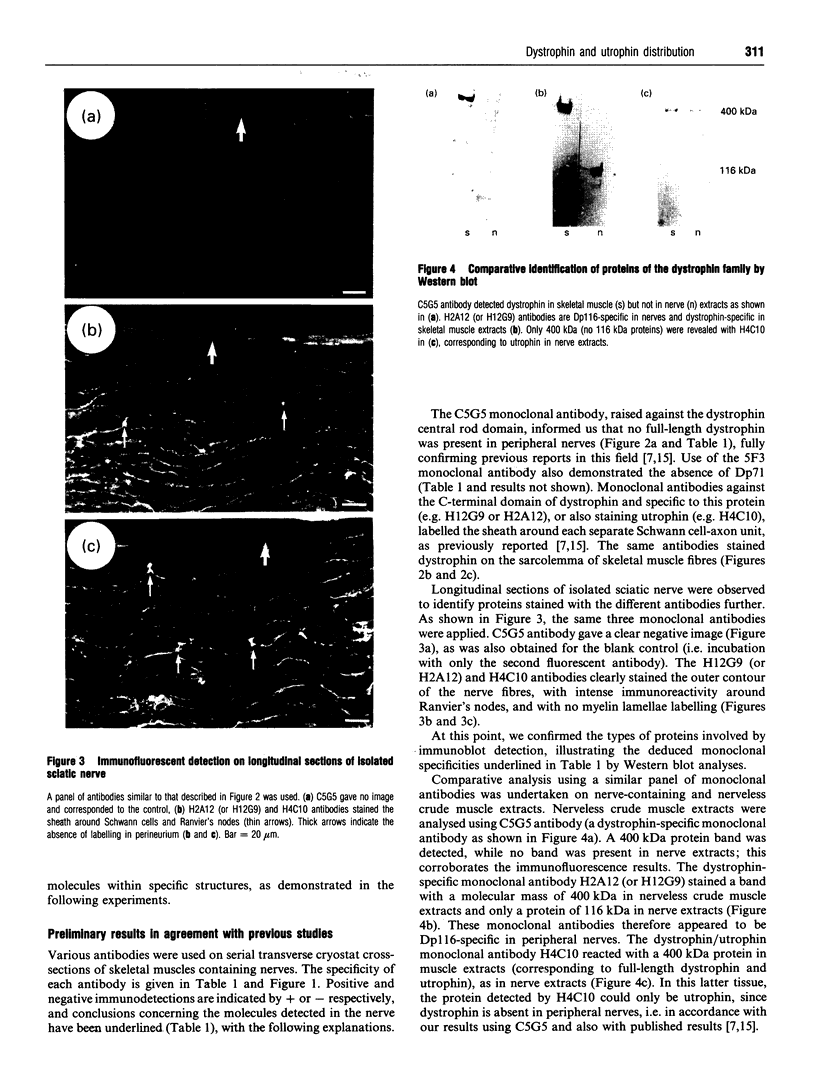
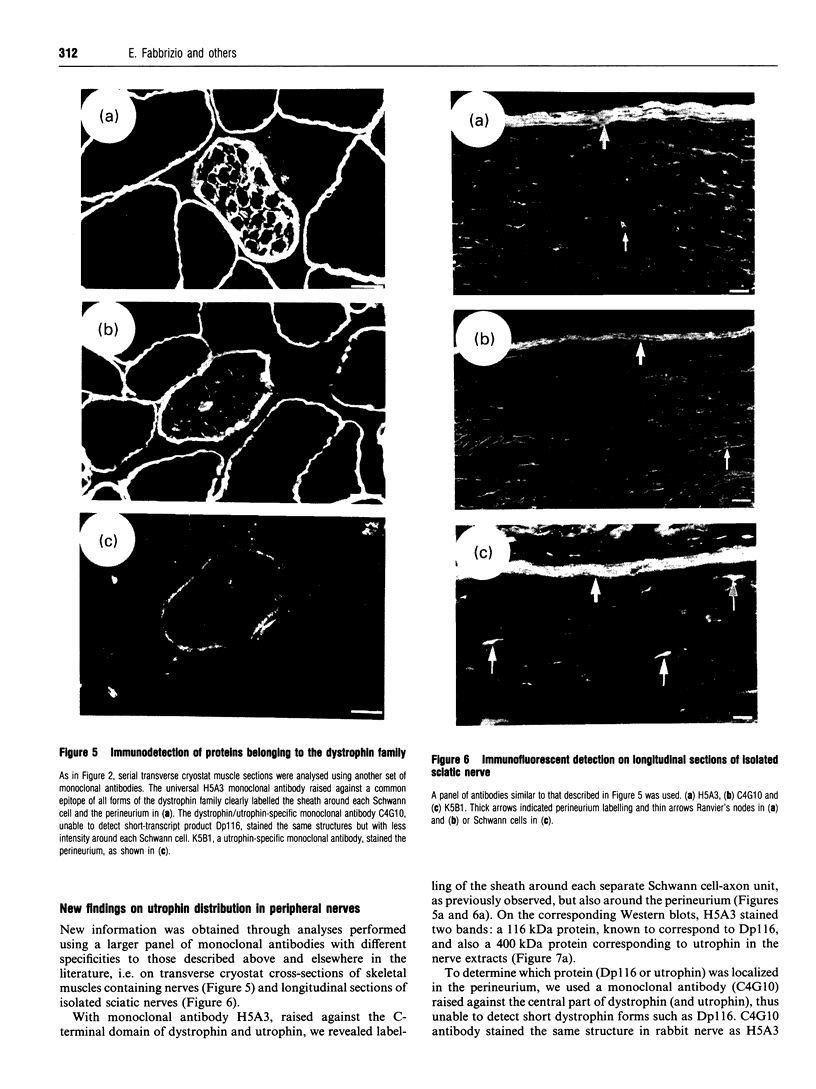
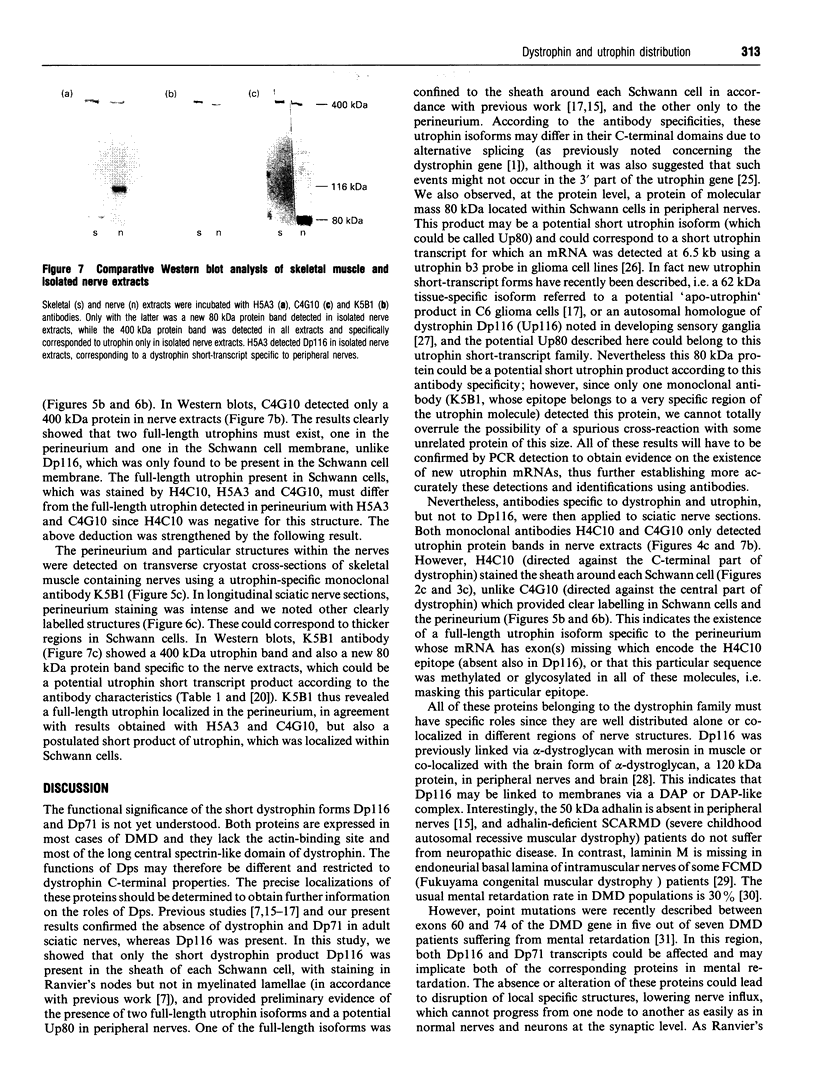
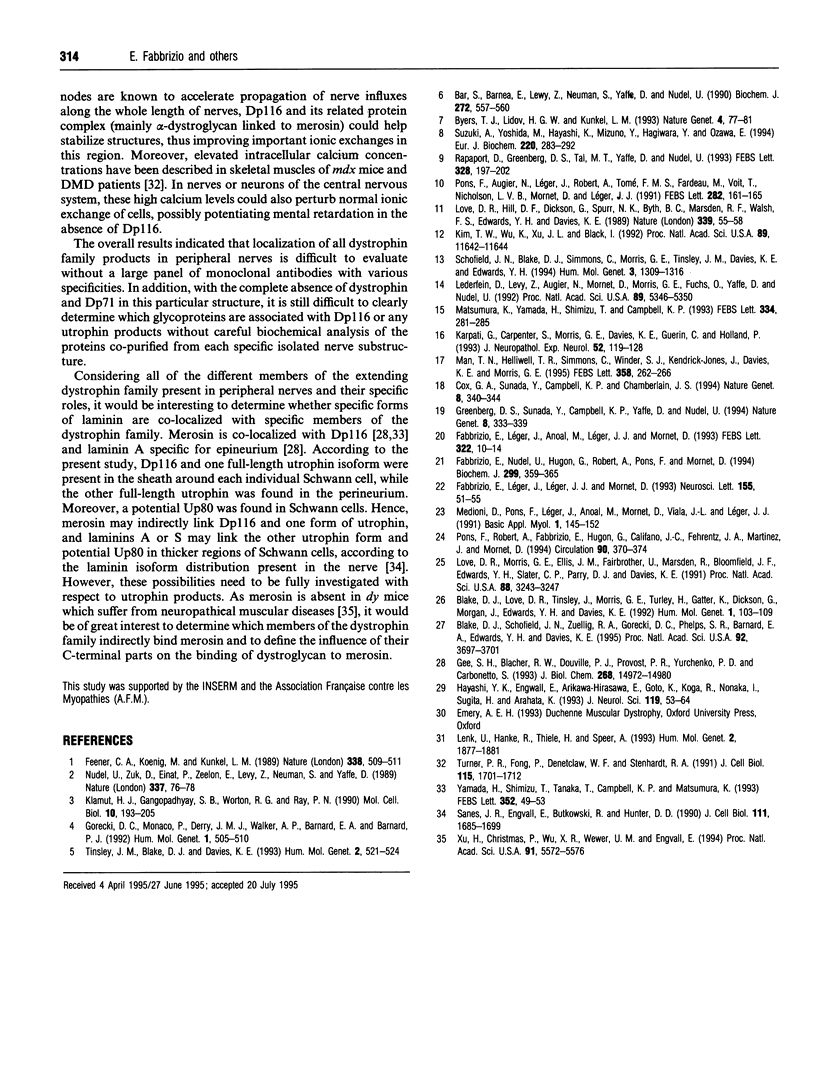
Images in this article
Selected References
These references are in PubMed. This may not be the complete list of references from this article.
- Bar S., Barnea E., Levy Z., Neuman S., Yaffe D., Nudel U. A novel product of the Duchenne muscular dystrophy gene which greatly differs from the known isoforms in its structure and tissue distribution. Biochem J. 1990 Dec 1;272(2):557–560. doi: 10.1042/bj2720557. [DOI] [PMC free article] [PubMed] [Google Scholar]
- Blake D. J., Love D. R., Tinsley J., Morris G. E., Turley H., Gatter K., Dickson G., Edwards Y. H., Davies K. E. Characterization of a 4.8kb transcript from the Duchenne muscular dystrophy locus expressed in Schwannoma cells. Hum Mol Genet. 1992 May;1(2):103–109. doi: 10.1093/hmg/1.2.103. [DOI] [PubMed] [Google Scholar]
- Blake D. J., Schofield J. N., Zuellig R. A., Górecki D. C., Phelps S. R., Barnard E. A., Edwards Y. H., Davies K. E. G-utrophin, the autosomal homologue of dystrophin Dp116, is expressed in sensory ganglia and brain. Proc Natl Acad Sci U S A. 1995 Apr 25;92(9):3697–3701. doi: 10.1073/pnas.92.9.3697. [DOI] [PMC free article] [PubMed] [Google Scholar]
- Byers T. J., Lidov H. G., Kunkel L. M. An alternative dystrophin transcript specific to peripheral nerve. Nat Genet. 1993 May;4(1):77–81. doi: 10.1038/ng0593-77. [DOI] [PubMed] [Google Scholar]
- Cox G. A., Sunada Y., Campbell K. P., Chamberlain J. S. Dp71 can restore the dystrophin-associated glycoprotein complex in muscle but fails to prevent dystrophy. Nat Genet. 1994 Dec;8(4):333–339. doi: 10.1038/ng1294-333. [DOI] [PubMed] [Google Scholar]
- Fabbrizio E., Leger J., Leger J. J., Mornet D. Dystrophin and dystrophin-related protein expression in Torpedo marmorata electric organ. Neurosci Lett. 1993 May 28;155(1):51–56. doi: 10.1016/0304-3940(93)90671-7. [DOI] [PubMed] [Google Scholar]
- Fabbrizio E., Léger J., Anoal M., Léger J. J., Mornet D. Monoclonal antibodies targeted against the C-terminal domain of dystrophin or utrophin. FEBS Lett. 1993 May 3;322(1):10–14. doi: 10.1016/0014-5793(93)81100-e. [DOI] [PubMed] [Google Scholar]
- Fabbrizio E., Nudel U., Hugon G., Robert A., Pons F., Mornet D. Characterization and localization of a 77 kDa protein related to the dystrophin gene family. Biochem J. 1994 Apr 15;299(Pt 2):359–365. doi: 10.1042/bj2990359. [DOI] [PMC free article] [PubMed] [Google Scholar]
- Feener C. A., Koenig M., Kunkel L. M. Alternative splicing of human dystrophin mRNA generates isoforms at the carboxy terminus. Nature. 1989 Apr 6;338(6215):509–511. doi: 10.1038/338509a0. [DOI] [PubMed] [Google Scholar]
- Gee S. H., Blacher R. W., Douville P. J., Provost P. R., Yurchenco P. D., Carbonetto S. Laminin-binding protein 120 from brain is closely related to the dystrophin-associated glycoprotein, dystroglycan, and binds with high affinity to the major heparin binding domain of laminin. J Biol Chem. 1993 Jul 15;268(20):14972–14980. [PubMed] [Google Scholar]
- Greenberg D. S., Sunada Y., Campbell K. P., Yaffe D., Nudel U. Exogenous Dp71 restores the levels of dystrophin associated proteins but does not alleviate muscle damage in mdx mice. Nat Genet. 1994 Dec;8(4):340–344. doi: 10.1038/ng1294-340. [DOI] [PubMed] [Google Scholar]
- Górecki D. C., Monaco A. P., Derry J. M., Walker A. P., Barnard E. A., Barnard P. J. Expression of four alternative dystrophin transcripts in brain regions regulated by different promoters. Hum Mol Genet. 1992 Oct;1(7):505–510. doi: 10.1093/hmg/1.7.505. [DOI] [PubMed] [Google Scholar]
- Hayashi Y. K., Engvall E., Arikawa-Hirasawa E., Goto K., Koga R., Nonaka I., Sugita H., Arahata K. Abnormal localization of laminin subunits in muscular dystrophies. J Neurol Sci. 1993 Oct;119(1):53–64. doi: 10.1016/0022-510x(93)90191-z. [DOI] [PubMed] [Google Scholar]
- Karpati G., Carpenter S., Morris G. E., Davies K. E., Guerin C., Holland P. Localization and quantitation of the chromosome 6-encoded dystrophin-related protein in normal and pathological human muscle. J Neuropathol Exp Neurol. 1993 Mar;52(2):119–128. doi: 10.1097/00005072-199303000-00004. [DOI] [PubMed] [Google Scholar]
- Kim T. W., Wu K., Xu J. L., Black I. B. Detection of dystrophin in the postsynaptic density of rat brain and deficiency in a mouse model of Duchenne muscular dystrophy. Proc Natl Acad Sci U S A. 1992 Dec 1;89(23):11642–11644. doi: 10.1073/pnas.89.23.11642. [DOI] [PMC free article] [PubMed] [Google Scholar]
- Klamut H. J., Gangopadhyay S. B., Worton R. G., Ray P. N. Molecular and functional analysis of the muscle-specific promoter region of the Duchenne muscular dystrophy gene. Mol Cell Biol. 1990 Jan;10(1):193–205. doi: 10.1128/mcb.10.1.193. [DOI] [PMC free article] [PubMed] [Google Scholar]
- Lederfein D., Levy Z., Augier N., Mornet D., Morris G., Fuchs O., Yaffe D., Nudel U. A 71-kilodalton protein is a major product of the Duchenne muscular dystrophy gene in brain and other nonmuscle tissues. Proc Natl Acad Sci U S A. 1992 Jun 15;89(12):5346–5350. doi: 10.1073/pnas.89.12.5346. [DOI] [PMC free article] [PubMed] [Google Scholar]
- Lenk U., Hanke R., Thiele H., Speer A. Point mutations at the carboxy terminus of the human dystrophin gene: implications for an association with mental retardation in DMD patients. Hum Mol Genet. 1993 Nov;2(11):1877–1881. doi: 10.1093/hmg/2.11.1877. [DOI] [PubMed] [Google Scholar]
- Love D. R., Hill D. F., Dickson G., Spurr N. K., Byth B. C., Marsden R. F., Walsh F. S., Edwards Y. H., Davies K. E. An autosomal transcript in skeletal muscle with homology to dystrophin. Nature. 1989 May 4;339(6219):55–58. doi: 10.1038/339055a0. [DOI] [PubMed] [Google Scholar]
- Love D. R., Morris G. E., Ellis J. M., Fairbrother U., Marsden R. F., Bloomfield J. F., Edwards Y. H., Slater C. P., Parry D. J., Davies K. E. Tissue distribution of the dystrophin-related gene product and expression in the mdx and dy mouse. Proc Natl Acad Sci U S A. 1991 Apr 15;88(8):3243–3247. doi: 10.1073/pnas.88.8.3243. [DOI] [PMC free article] [PubMed] [Google Scholar]
- Matsumura K., Yamada H., Shimizu T., Campbell K. P. Differential expression of dystrophin, utrophin and dystrophin-associated proteins in peripheral nerve. FEBS Lett. 1993 Nov 22;334(3):281–285. doi: 10.1016/0014-5793(93)80695-q. [DOI] [PubMed] [Google Scholar]
- Nguyen T. M., Helliwell T. R., Simmons C., Winder S. J., Kendrick-Jones J., Davies K. E., Morris G. E. Full-length and short forms of utrophin, the dystrophin-related protein. FEBS Lett. 1995 Jan 30;358(3):262–266. doi: 10.1016/0014-5793(94)01441-3. [DOI] [PubMed] [Google Scholar]
- Nudel U., Zuk D., Einat P., Zeelon E., Levy Z., Neuman S., Yaffe D. Duchenne muscular dystrophy gene product is not identical in muscle and brain. Nature. 1989 Jan 5;337(6202):76–78. doi: 10.1038/337076a0. [DOI] [PubMed] [Google Scholar]
- Pons F., Augier N., Léger J. O., Robert A., Tomé F. M., Fardeau M., Voit T., Nicholson L. V., Mornet D., Léger J. J. A homologue of dystrophin is expressed at the neuromuscular junctions of normal individuals and DMD patients, and of normal and mdx mice. Immunological evidence. FEBS Lett. 1991 Apr 22;282(1):161–165. doi: 10.1016/0014-5793(91)80468-i. [DOI] [PubMed] [Google Scholar]
- Pons F., Robert A., Fabbrizio E., Hugon G., Califano J. C., Fehrentz J. A., Martinez J., Mornet D. Utrophin localization in normal and dystrophin-deficient heart. Circulation. 1994 Jul;90(1):369–374. doi: 10.1161/01.cir.90.1.369. [DOI] [PubMed] [Google Scholar]
- Rapaport D., Greenberg D. S., Tal M., Yaffe D., Nudel U. Dp71, the nonmuscle product of the Duchenne muscular dystrophy gene is associated with the cell membrane. FEBS Lett. 1993 Aug 9;328(1-2):197–202. doi: 10.1016/0014-5793(93)80992-4. [DOI] [PubMed] [Google Scholar]
- Schofield J. N., Blake D. J., Simmons C., Morris G. E., Tinsley J. M., Davies K. E., Edwards Y. H. Apo-dystrophin-1 and apo-dystrophin-2, products of the Duchenne muscular dystrophy locus: expression during mouse embryogenesis and in cultured cell lines. Hum Mol Genet. 1994 Aug;3(8):1309–1316. doi: 10.1093/hmg/3.8.1309. [DOI] [PubMed] [Google Scholar]
- Suzuki A., Yoshida M., Hayashi K., Mizuno Y., Hagiwara Y., Ozawa E. Molecular organization at the glycoprotein-complex-binding site of dystrophin. Three dystrophin-associated proteins bind directly to the carboxy-terminal portion of dystrophin. Eur J Biochem. 1994 Mar 1;220(2):283–292. doi: 10.1111/j.1432-1033.1994.tb18624.x. [DOI] [PubMed] [Google Scholar]
- Tinsley J. M., Blake D. J., Davies K. E. Apo-dystrophin-3: a 2.2kb transcript from the DMD locus encoding the dystrophin glycoprotein binding site. Hum Mol Genet. 1993 May;2(5):521–524. doi: 10.1093/hmg/2.5.521. [DOI] [PubMed] [Google Scholar]
- Turner P. R., Fong P. Y., Denetclaw W. F., Steinhardt R. A. Increased calcium influx in dystrophic muscle. J Cell Biol. 1991 Dec;115(6):1701–1712. doi: 10.1083/jcb.115.6.1701. [DOI] [PMC free article] [PubMed] [Google Scholar]
- Xu H., Christmas P., Wu X. R., Wewer U. M., Engvall E. Defective muscle basement membrane and lack of M-laminin in the dystrophic dy/dy mouse. Proc Natl Acad Sci U S A. 1994 Jun 7;91(12):5572–5576. doi: 10.1073/pnas.91.12.5572. [DOI] [PMC free article] [PubMed] [Google Scholar]
- Yamada H., Shimizu T., Tanaka T., Campbell K. P., Matsumura K. Dystroglycan is a binding protein of laminin and merosin in peripheral nerve. FEBS Lett. 1994 Sep 19;352(1):49–53. doi: 10.1016/0014-5793(94)00917-1. [DOI] [PubMed] [Google Scholar]



